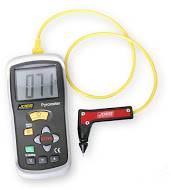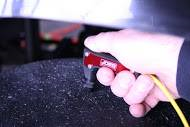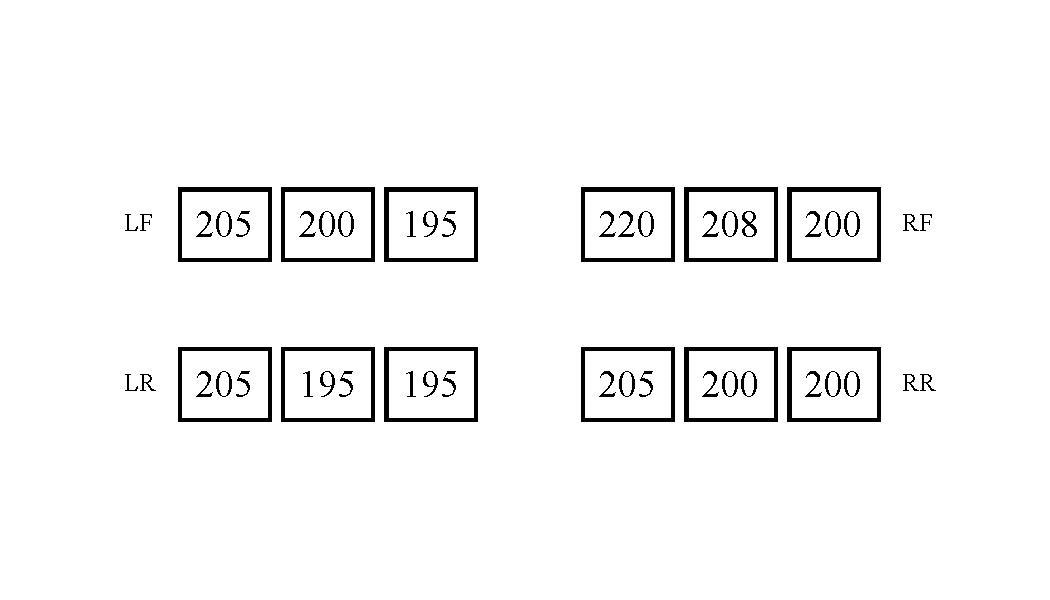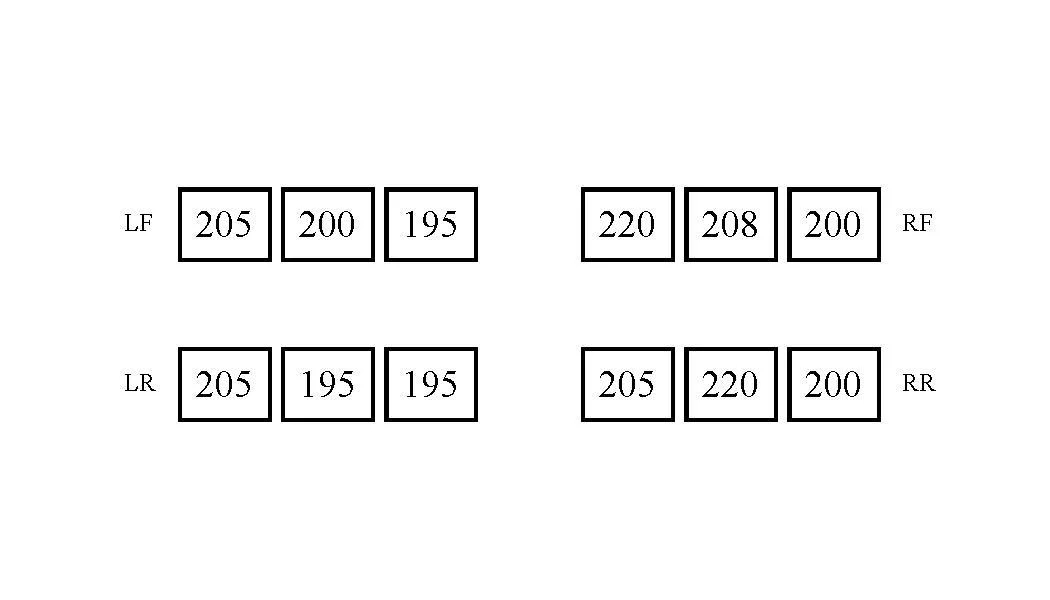You spend piles of time figuring out how to make more horsepower, optimizing shocks and building lighter cars which all come together where the rubber meets the road. Every speed secret on your car is applied at the contact patch so creating the optimal footprint is the meeting place for all of your hard work. Tires are the single most important aspect of speed as every adjustment from motors to springs relies on the grip you manufacture at the contact patch.
Measuring tire temperatures accurately will provide the information you need to produce even grip and maximum friction where it matters most. Using pyrometers correctly provides valuable information. Often, a tire sheet is handed to the crew chief and the numbers on the paper sets in motion a flurry of adjustments. The thrash begins and springs fly. Orders are barked and the crew moves quickly to get the car back on the track with hopeful anticipation of new found speed. Temps are taken to see how the new adjustments worked out and too often the intended chassis improvements are 180 from what is needed. The driver reports the car is even worse than before the recent round of adjustments. Did the missed set up attempt occur due to a poor choice on the chassis adjustment? Or – were the wrong changes made due to poorly measured numbers on the original tire temp sheet?
It is worth noting that tire temps and pyrometers are one of the few ways that you can analyze real time data right at the track. If the temperature measurements are taken correctly, chassis specialists can calculate the best changes that will perform for the length of the run. Using up important practice time and valuable practice tires with wrong way adjustments is expensive. Choosing the correct pyrometer to produce scientific information and assigning the crew member that is dedicated to precision is paramount.
Pyrometer
 To dissipate heat racing tires are very thin. Thick tire rubber holds in heat and the potential for blistering increases. Tire engineers balance the rubber thickness with tire compounds to produce a package that considers car weight, corner speed, track abrasiveness, outside temperature, intended lap use and several other variables. Since the thickness of tire rubber can vary you need a pyrometer with an adjustable tip length probe. We want consistency and measuring tire temperature down at the cord is the best way to ensure accurate and repeatable numbers. If your team is measuring tire temps at varying depths then the information on the tire sheet is going to set in motion changes that could slow your car down.
To dissipate heat racing tires are very thin. Thick tire rubber holds in heat and the potential for blistering increases. Tire engineers balance the rubber thickness with tire compounds to produce a package that considers car weight, corner speed, track abrasiveness, outside temperature, intended lap use and several other variables. Since the thickness of tire rubber can vary you need a pyrometer with an adjustable tip length probe. We want consistency and measuring tire temperature down at the cord is the best way to ensure accurate and repeatable numbers. If your team is measuring tire temps at varying depths then the information on the tire sheet is going to set in motion changes that could slow your car down.
Pyrometers must be used constantly – scientifically. Rubber is a poor conductor of heat yet it is a great insulator. If you are trying to assess camber temperature curves then you want to know the inside, middle and outside temps based on your camber setting and corner performance. If you measure the inside location at the rubber surface, the middle location and mid tread depth and the outside at the cord your temp sheet is going to have more inconsistency than Michael Jackson has had cosmetic procedures. The cord heat is insulated away from the outside elements and the most heat will be found beneath the rubber and down at the cord. Scientifically – it makes sense to measure all 12 locations at cord depth where the purest temperature is located.
Adjust your pyrometer probe so that the adjuster stops the probe penetration just before the probe reaches the tire cord. Using the stop on the adjustable tip will allow your crew to quickly and consistently get down to a consistent depth near the cord each and every time. Your temp sheet will provide scientific quality information due to the repeatable and consistent probe depth.
Tire Probe
 Reading rubber temperature down at the cord is best as the friction of your tire pulls and stretches the tire rubber. The stretching effect creates heat just like when you bend a coat hanger back and forth. More friction creates more contact rubber stretch. Measuring down near the cord displays the data resulting in efficient chassis adjustments.
Reading rubber temperature down at the cord is best as the friction of your tire pulls and stretches the tire rubber. The stretching effect creates heat just like when you bend a coat hanger back and forth. More friction creates more contact rubber stretch. Measuring down near the cord displays the data resulting in efficient chassis adjustments.
If you have a pyrometer with a fixed tip you can make it work but you introduce depth variables. How many times have you seen a temp sheet that showed you needed to take out RF camber and sent the car back out without an adjustment. A second temp reading shows you have too much camber – I will bet probe depth variation is the issue. With a fixed tip your crew needs to “feel” the cord to ensure the probe is at a repeatable and consistent depth.
Your probe tip is made of thin steel which heats up quickly sucking the heat out of the pin hole made in the tire rubber. Be sure to move quickly. If you leave the probe in one spot in the tire rubber and watch the display you will see the temp rise and then begin to fall as the heat is sucked out of the test location. You need to record the maximum temp in each probe location. High quality pyrometers lock in the maximum temperature automatically increasing accuracy. Utilizing a temp lock feature gets you around the car in nearly half the time.
I am often asked if Infra Red pyrometers are good for tires. You certainly can use Infra Red pyrometers for tires but it is a quick check and the information is simply less precise than using an adjustable tip probe. IR pyrometers measure the tire surface. The surface temperature is impacted by engine heat, brake heat, puddles etc. Camber in the front tires places only a few inches of the tire on the ground at the low speeds encountered when travelling back to the pit area. The track surface is cooler than tire operating temps so the tire surface area in contact with the ground pull heat from the strip in contact with the track at a different rate than the rest of the tire – this difference skews your camber curve readings. The rubber down at the cord is insulated for a longer period giving you more time to measure temps relative to on track performance and probes can reach down past the surface for a better look.
When using IR pyrometers for tire temps bear in mind that the surface recordings will be much cooler in comparison to probes and you will lose the fine detail that can be found with probe type pyrometers. IR pyrometers are great tools for measuring track, header, brake and cockpit temps. Using the right tool for the job is usually sound advice.
To ensure the best relative tire temp readings follow these steps:
- Use a properly adjusted pyrometer probe tip to measure down at the cord.
- Get to the car quickly – speed matters!
- Record the highest temp at each location with an automatic max temp feature or by manually witnessing the highest temperature. Move around the car quickly.
- Start at the same tire each and every time and record the individual Inside, Middle and Outside for all 4 tires. Consistency is the goal.
- Record track temp and outside air temperature on your tire sheet to monitor the difference that these variables have on your tire temps – over time you will be able to forecast better compensating adjustments.
- Keep in mind that tire temps are of more value on a car that is handling well and with tires that are in good shape. Tire temps on cars that are in left field are about as valuable as politicians’ promises.
Using your scientific tire temps you can evolve my rule of thumb tips shown below. My tips are based on a car that is set up properly and just needs fine tuning. Your team should adjust the suggestions below based on your real world testing and document your own pre-determined adjustment to form your own game plan. Creating a game plan in advance will allow you to quickly asses your adjustment options improving your decision making when things get hectic at the track.
Camber Adjustments
Your tire sheet temperatures suggest a camber adjustment is needed but knowing the adjustment amount is an educated guess. My rule of thumb for adjusting camber is a 1/8” shim for 12 degrees of temp difference between the inside and the outside. A 1/16th shim is a good start for 6 degrees difference. Trial and error starts somewhere and your team can modify my rule of thumb based on your actual conditions. Strive to find and document a pre-determined shim thickness associated with the degree difference across the tires on your car.
Starting Cold Air Pressures
Air pressure and tire temperature work hand in hand. If you take precision tire temp measurements you can gain an advantage over the competition by adjusting your cold air pressures before the race based on data you have collected over time. You can adjust your pre-race air pressures to a finer degree if you record outside and track surface temps in conjunction with your tire temperatures. If it is really hot out and you have tire temps that are 20 degrees higher than your last trip to a given track you can adjust the cold temps for better race performance. The rule of thumb that I used on a 2900 pound touring late model with bias ply tires was 1 degree of pressure gain for every 10 degrees of additional tire heat. You can visualize that there would be more pressure gain in the heat of summer verses a cool spring. Testing dictates your actual heat induced air pressure compensations. Adjusting your pressures based on recorded results will help you to optimize pressures for more speed on a long green flag run. Understanding the correlation between pressure and temperature will help you to optimize pre-race pressures during those times when your race set has residual temperature from practice and the race is going to start before the tires cool completely. Strive to know the actual temperature induced pressure gain based on your driver, track and conditions.
Air Pressure Adjustments
Inflating each individual tire properly means better grip, more wear and more speed. With accurate tire temps my rule of thumb is to adjust individual pressures 1 pound for every 5 degrees of over or under inflation shown as hot or cold center temps on my temp sheet. Your team can tailor the starting point of this rule of thumb to your actual situation. Your team may decide on 1 pound per 4 degrees or something different but the goal is to find the pressure needs for your car and tires. Establishing a baseline for inflation pressure adjustments will help you to dial in the winning set up and add consistency to your set up process.
Measure and record your tire temps with a quality pyrometer. Use the scientific data to form a pre-race game plan. Use your game plan to make the right call when it matters most. By using science you can take the black magic mystery out of your tires by building consistency in your adjustment process.


